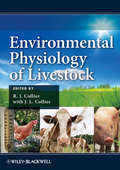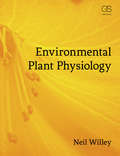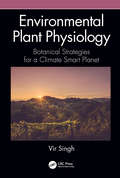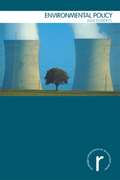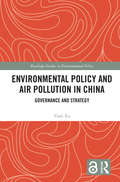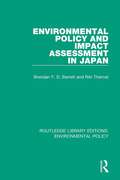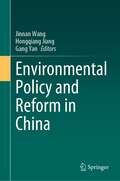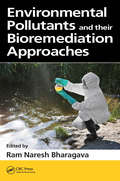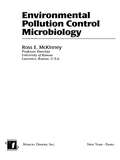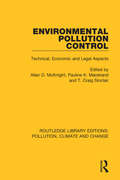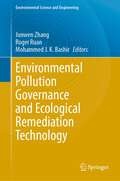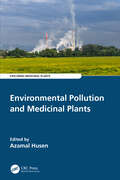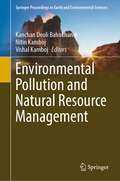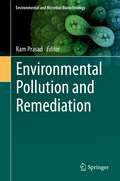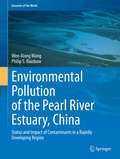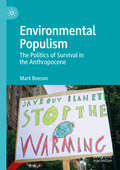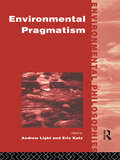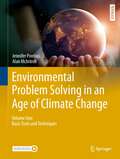- Table View
- List View
Environmental Physiology of Livestock
by R. J. CollierEnvironmental stress is one of the most significant factors affecting livestock performance and health, and it is only expected to increase with effects of global warming. Environmental Physiology of Livestock brings together the latest research on environmental physiology, summarizing progress in the field and providing directions for future research. Recent developments in estimating heat stress loads are discussed, as well as key studies in metabolism, reproduction, and genetic expressions. Environmental Physiology of Livestock begins with a survey of current heat indexing tools, highlighting recent discoveries in animal physiology, changes in productivity levels, and new technologies available to better estimate stress response. Using this synopsis as a point of orientation, later chapters hone in on major effects of heat stress, including changing metabolic pathways and nutrient requirements, endocrine regulation of acclimation to environmental stress, and reduced reproductive performance. The text concludes with a thorough discussion of environmental effects on gene expressions, providing important insight for future breeding practices. Environmental Physiology of Livestock is a globally contributed volume and a key resource for animal science researchers, geneticists, and breeders.
Environmental Plant Physiology
by Neil WilleyEnvironmental Plant Physiology focuses on the physiology of plant-environment interactions, revealing plants as the key terrestrial intersection of the biosphere, atmosphere, hydrosphere and geosphere. It provides a contemporary understanding of the topic by focusing on some of humankind's fundamental biological, agricultural and environmental challenges. Its chapters identify thirteen key environmental variables, grouping them into resources, stressors and pollutants, and leading the reader through how they challenge plants and how plants respond at molecular, physiological, whole plant and ecological levels. The importance of taking account of spatial and temporal dimensions of environmental change in order to understand plant function is emphasised. The book uses a mixture of ecological, environmental and agricultural examples throughout in order to provide a holistic view of the topic suitable for a contemporary student audience. Each chapter uses a novel stress response hierarchy to integrate plant responses across spatial and temporal scales in an easily digestible framework.
Environmental Plant Physiology: Botanical Strategies for a Climate Smart Planet
by Vir SinghEnvironmental Plant Physiology provides a stupendous knowledge source for undergraduate and graduate students and their teachers in many inter-related disciplines, like life sciences, agricultural sciences, environmental sciences, ecology, and climatology. Further, this book can also be of vital importance for policy makers and organizations dealing with climate related issues and committed to the cause of the Earth. This book can be instrumental in formulating strategies that can lead us to a climate smart planet. Features: Ecological basis of environmental plant physiology. Energy, nutrient, water, temperature, allelochemical and altitude relations of plants. Stress physiology of plants. Climate change effects on plant physiology. Plants’ adaptations to the changing climate. Evolving botanical strategies for a climate smart planet.
Environmental Policy (Routledge Introductions to Environment: Environment and Society Texts)
by Jane RobertsWithin the overall context of sustainable development Environmental Policy discusses the opportunities and constraints that environmental systems place upon the operation of human systems. It suggests environmental policy is a potential way to modify the operation of human systems so that they function within environmental constraints. Key social scientific concepts (political, social and economic) are used to explain the background for the formulation and implementation of environmental policy.Environmental problems, the role of humans in creating them, sustainable development and how this concept relates to environmental policy are all introduced. The book then considers environmental policy formulation, implementation and evaluation, within three specific contexts: the firm, the nation state and at the international level. It also reviews the place of economics, science and technology in environmental policy.Detailed case-studies, drawn from a range of international examples, are used throughout to illustrate issues such as global warming, international trade, tourism and the human rights of indigenous peoples. It is well illustrated and includes end of chapter summaries and further reading.
Environmental Policy and Air Pollution in China: Governance and Strategy (Routledge Studies in Environmental Policy)
by Yuan XuThis book systematically analyzes how and why China has expectedly lost and then surprisingly gained ground in the quest to solve the complicated environmental problem of air pollution over the past two decades. Yuan Xu shines a light on how China’s sulfur dioxide emissions rose quickly in tandem with rapid economic growth but then dropped to a level not seen for at least four decades. Despite this favorable mitigation outcome, Xu details how this stemmed from a litany of policy stumbles within the Chinese context of no democracy and a lack of sound rule of law. Throughout this book, the author examines China’s environmental governance and strategy and how they shape environmental policy. The chapters weave together a goal-centered governance model that China has adopted of centralized goal setting, decentralized goal attainment, decentralized policy making and implementation. Xu concludes that this model provides compelling evidence that China’s worst environmental years reside in the past. This book will be of great interest to students and scholars of Chinese environmental policy and governance, air pollution, climate change and sustainable development, as well as practitioners and policy makers working in these fields.
Environmental Policy and Impact Assessment in Japan (Routledge Library Editions: Environmental Policy #2)
by Riki Therivel Brendan F. BarrettFirst published in 1991. Japanese attitudes to pollution and environmental protection were distinctly equivocal. The Japanese are a nature-loving people, yet they are responsible for widespread environmental destruction; Japan has some of the world’s strictest environmental quality standards, but the country also has some of the world’s most environmentally damaged areas. In this book the authors present a broad and detailed analysis of policy and process in Japan in the late twentieth century. Brendan Barrett and Riki Therivel, who both have extensive research experience in Japan, describe interest group participation in Japan’s environmental policy-making and give an historical review of the relationship between economic growth and environmental problems. They look at the framework for environmental policy-making and outline the system for environmental management. This is complemented by a discussion of Environmental Impact Assessment, and by live case studies of the practical realities of EIA in Japan. With environmental problems reaching global proportions, countries all over the world have much to learn from the experience of Japan, and the book will be extremely useful to national government officials, to local planning officers responsible for EIA, and to environmental consultants working for commercial and industrial companies. It will also be essential reading for students of geography, environmental studies, Japanese studies and planning economics.
Environmental Policy and Public Health
by Barry L. Johnson Maureen Y. LichtveldAs with the first edition, this second edition describes how environmental health policies are developed, the statutes and other policies that have evolved to address public health concerns associated with specific environmental hazards, and the public health foundations of the policies. It lays out policies for what is considered the major environmental physical hazards to human health. Specifically, the authors describe hazards from air, water, food, hazardous substances, and wastes. To this list the authors have added the additional concerns from climate change, tobacco products, genetically-modified organisms, environment-related diseases, energy production, biodiversity and species endangerment, and the built environment. And as with the first edition, histories of policymaking for specific environmental hazards are portrayed. This edition differs from its antecedent in three significant themes. Global perspectives are added to chapters that describe specific environmental hazards, e.g., air pollution policies in China and India. Also there is the material on the consequences of environmental hazards on both human and ecosystem health. Additionally readers are provided with information about interventions that policymakers and individuals can consider in mitigating or preventing specific environmental hazards.
Environmental Policy and Public Health: Emerging Health Hazards and Mitigation, Volume 2
by Barry L. Johnson Maureen Y. LichtveldWritten by environmental health experts with long teaching and professional careers in policy and public health, the third edition of Environmental Policy and Public Health comprises two volumes, addressing key physical hazards in the environment that impact public health. The first volume on Principal Health Hazards and Mitigation is complemented by the second volume, Emerging Health Hazards and Mitigation. Volume 2 discusses emerging health hazards and mitigation including environment-related infectious diseases, COVID-19 pandemic, social justice, and drugs and public health. New in this volume are a chapter on firearms violence as a public health hazard, a chapter on transportation and how built environments can affect human health and social well-being, and a chapter on noise and light pollution. As human populations increase and technology adds more devices to daily use that generate noise and light, adverse human and ecological health effects have become recognizable and require time-sensitive policy actions to mitigate and where possible prevent adverse health effects. Each chapter explains with great clarity how new environmental health issues are translated into public health policies. The volume concludes with case studies and practice questions to facilitate interactive learning for upper-level undergraduate and graduate students taking courses in public health and environmental sciences. The case studies and practice questions allow for a diverse portfolio of in-person and hybrid pedagogical strategies and tools at the fingertips of faculty who not only teach policy courses but whose course topics have policy relevance, such as climate and health.
Environmental Policy and Public Health: Principal Health Hazards and Mitigation, Volume 1
by Barry L. Johnson Maureen Y. LichtveldWritten by environmental health experts with long teaching and professional careers in policy and public health, the third edition of Environmental Policy and Public Health comprises two volumes addressing key physical hazards in the environment that impact public health. The first volume on Principal Health Hazards and Mitigation is complemented by the second volume, Emerging Health Hazards and Mitigation. The health of the environment is inextricably linked to that of people. Thoroughly updated, Volume 1 describes how the quality of air, water, and food is threatened by the presence of toxic substances and explains why climate change is a global health priority already impacting human health and the environment. The mitigations discussed in this volume are twofold: policies that are intended for control of specific hazards and suggested hazard interventions. The role of policy in addressing each of these key environmental health areas is extensively discussed in this volume as well. Each chapter explains step by step how new environmental health issues are translated into public health policies and concludes with practice questions to facilitate interactive learning for upper-level undergraduate and graduate students taking courses in public health and environmental sciences. The step-by step approach, as well as the case studies and practice questions, allow for a diverse portfolio of in-person and hybrid pedagogical strategies and tools at the fingertips of faculty who not only teach policy courses, but whose course topics, such as climate and health, have policy relevance.
Environmental Policy and Reform in China
by Jinnan Wang Hongqiang Jiang Gang YanThe book is the collection of the latest research results from Chinese Academy of Environmental Planning in environmental policy and reform during the past years, mainly related to ecological compensation, the emission trading, the environment audit, carbon tax, environment friendly city, environmental health, economic policy in medical waste, scattered coal treatment subsidies, environmental policy efficiency analysis, environmental industry statistics, environmental performance evaluation, green fiscal and taxation policy, etc., presenting the latest achievements, developments and research trends in this field.
Environmental Policy is Social Policy – Social Policy is Environmental Policy
by Isidor WallimannThis book argues that social and environmental policy should be synthetically treated as one and the same field, that both are but two aspects of the same coin - if sustainability is the goal. Such a paradigm shift is indicated, important, and timely to effectively move towards sustainability. This book is the first to take this approach and to give examples for it. Not to synthetically merge the two fields has been and will continue to be highly insufficient, inefficient and contradictory for policy and public administration aiming for a transformation towards a sustainable world. In general, social problems are dealt with in one "policy corner" and environmental problems in another. Rarely is social policy (at large) concerned with its impact on the environment or its connection with and relevance to environmental policy. Equally, environmental problems are generally not seen in conjunction with social policy, even though much environmental policy directly relates to health, nutrition, migration and other issues addressed by social policy. This book intends to correct the pattern to separate these very significant and large policy fields. Using examples from diverse academic and applied fields, it is shown how environmental policy can (and should) be thought of as social policy - and how social policy can (and should) simultaneously be seen as environmental policy. Tremendous benefits are to be expected.
Environmental Pollutants and their Bioremediation Approaches
by Ram Naresh BharagavaThis book is a compilation of detailed and latest knowledge on the various types of environmental pollutants released from various natural as well as anthropogenic sources, their toxicological effects in environments, humans, animals and plants as well as various bioremediation approaches for their safe disposal into the environments. In this book, an extensive focus has been made on the various types of environmental pollutants discharged from various sources, their toxicological effects in environments, humans, animals and plants as well as their biodegradation and bioremediation approaches for environmental cleanup.
Environmental Pollution Control Microbiology: A Fifty-Year Perspective (Civil And Environmental Engineering Ser. #Vol. 16)
by Ross E. McKinneyCompiling knowledge gained through more than 50 years of experience in environmental engineering technology, this book illustrates the application of fundamental concepts in microbiology to provide a sound basis for the design and operation of various biological systems used in solving environmental challenges in the air, water, and soil. Environme
Environmental Pollution Control: Technical, Economic and Legal Aspects
by Allan D. McKnight Pauline K. Marstrand T. Craig SinclairOriginally published in 1974 this volume brings together contributions from lawyers, a nuclear physicist, a landscape architect, biologist, engineers and a former Inspector of the International Atomic Energy Agency. It covers technical and legal information on air, water, sea, land and noise pollution and provides a comprehensive guide, summary and introduction to the journal literature in separate but relevant disciplines. All of the contributors have specialised in studies in pollution control and contributed to the debate on use and management of the environment.
Environmental Pollution Governance and Ecological Remediation Technology (Environmental Science and Engineering)
by Junwen Zhang Roger Ruan Mohammed J. K. BashirThis book provides the advance research results of environmental pollution and governance and covers the main research field of environmental remediation, environmental monitoring, sanitation and so on. Nowadays, environmental pollution, as one of the most important problems in the world, has seriously affected the global ecology, temperature, water resources and so on. Therefore, the research on environmental governance can better help us comprehend the methods and measures of environmental protection and protect our ecology more scientifically and effectively. This book also aims to promote scientific information interchange between scholars from the top universities, research centers and high-tech enterprises working all around the world. It is beneficial to scholars, engineers and researchers in the field of environmental engineering and environmental governance.
Environmental Pollution and Community Rebuilding in Modern Japan
by Keiji Fujiyoshi Masafumi Yokemoto Miho Hayashi Mayuko ShimizuThis book describes how modern industry affected people in Japan and their communities by polluting their living environment with toxic emissions. It also shows how the populace endeavored not only to restore their once-clean environment but also to rebuild communities that had been damaged by pollution and its accompanying effects. Environmental pollution is usually referred to in Japan as kogai, public damage, meaning that such pollution not only harms the physical environment—air, water, soil, and the human body—but also destroys the social and personal relationships in the polluted area. Those people who took action recognized that industrial and economic development had been given the highest national priority even at the cost of their health and welfare. In this sense, anti-kogai movements led them to alternative community development and to rethinking what kind of environment and community they wanted. This book also explores the efforts driven by residents in several parts of Japan after the middle of the twentieth century and the endeavors of museums and archives as a memorial to those who suffered from the pollution and for the prospect of a better society with a good environment.
Environmental Pollution and Medicinal Plants (Exploring Medicinal Plants)
by Azamal HusenEnvironmental Pollution and Medicinal Plants presents information on the impact of environmental pollution on the performance of medicinal plants at various levels including damage detection, adaptation, tolerance, and physiological and molecular responses.This title draws attention not only to seeking new bioactive compounds for herbal drug preparation, but also on ensuring high standards of quality through evaluation of the chemical purity of medicinal plants growing under polluted conditions. It discusses the latest trends and responses of medicinal plants, indicating their tolerance and adaptation to environmental pollution. This book also focuses on secondary metabolites, phytochemicals, and bioactive compounds associated with medicinal plants growing in contaminated conditions.This book will be indispensable for students and professionals working in the field of environmental pollution, medicinal plants, and herbal medicine, as well as for plant biologists, economic botanists, molecular biologists, and biotechnologists.. KEY FEATURES Explains the global trend of environmental pollution and its impact on medicinal herbs with the help of clear text and attractive illustrations. Provides a comprehensive overview of medicinal plants and their interaction with environmental pollution in terms of damage detection, repair, acclimation, tolerance, adaptation, and physiological responses. Discusses the production of secondary metabolites, phytochemicals, and bioactive compounds (used for herbal drug preparation) in medicinal plants growing in the vicinity of contamination and pollution load. Highlights opportunities and future challenges in "omics" studies on medicinal plants.
Environmental Pollution and Natural Resource Management (Springer Proceedings in Earth and Environmental Sciences)
by Kanchan Deoli Bahukhandi Nitin Kamboj Vishal KambojThis book presents conference articles related to environmental pollution and natural resource management, and environmentally friendly technologies that lead to sustainable development presented in the Conference "Sustainable Management of Environment & Natural Resource Through Innovation in Science and Technology". The book highlights the latest development and innovation in environmental science, technology, and interdisciplinary research to improve the environment and health safety. It includes innovations and improvisations in the broad area of science and technology, natural resource, and environment management. It deliberates on the current burning issues of environment protection management and sustainable development, environmental pollution, global warming, and climate change.The development strategies must therefore be shaped by the following components:The satisfaction of basic human requirementsThe eradication of povertySelf-reliant and participatory developmentEnvironmental consciousnessTechnology has to play a critical role in the process of changing industrial society. But innovation has to be embedded in social and organizational innovation. This book provides a wide range of research articles in the area of science and technology, sustainability, natural resource management, ecology and its environmental fields, geosciences and geology, atmospheric sciences, sustainability, climate change, and extreme weather, global warming, and environmental change, the effect of climate change on the ecosystem, environment, and pollution.
Environmental Pollution and Plant Responses
by Madhoolika Agrawal Shashi Bhushan AgrawalComprehensive and global in scope, Environmental Pollution and Plant Responses provides an analysis of the research on the factors contributing to the deteriorating environmental quality and its effect on plant performance. The issues include: environmental pollution and global climate change, response patterns of plants at different levels, mechanisms of interaction, tolerance strategies and future research prospects. The author evaluates trends and gives management strategies for abating the problem. This volume highlights the complexities of environmental problems and the affect of pollution on every level of the ecosystem.
Environmental Pollution and Remediation (Environmental and Microbial Biotechnology)
by Ram PrasadThis book presents state-of-the-art environmental remediation processes. Environmental protection and management is a global concern, especially in the context of industrial regions. Over the years, several conventional, engineering-based physicochemical decontamination methods have used in the remediation of polluted sites. However, these methods are expensive and have limited efficiency. Drawing on research and examples from around the world, this book offers a comprehensive review of and insights into green technologies and sustainable remediation alternatives. It discusses the emerging importance of nanotechnology, chemo and biosensors, indicator species, microbe-based remediation of organic compounds, and ex-situ remediation methods. Addressing the growing global need for a holistic overview of the environmental remediation of polluted sites, it will appeal to teachers, researchers, scientists, capacity builders, and policymakers. It also serves as additional reading material for undergraduate and graduate students of biotechnology and environmental sciences.
Environmental Pollution of Paddy Soils (Soil Biology #53)
by Ajit Varma Muhammad Zaffar HashmiThe paddy field is a unique agro-ecosystem and provides services such as food, nutrient recycling and diverse habitats. However, chemical contamination of paddy soils has degraded the quality of this important ecosystem. This book provides an overview of our current understanding of paddy soil pollution, addressing topics such as the major types of pollutants in contaminated paddy soil ecosystems; factors affecting the fate of pollutants in paddy soil; biomonitoring approaches to assess the contaminated paddy soil; the impact of chemicals on soil microbial diversity; and climate change. It also covers arsenic and heavy metal pollution of paddy soils and their impact on rice quality. Further, new emerging contaminants such as antibiotics and antibiotics resistance genes (ARGs) in paddy soil and their impact on environmental health are also discussed. The last chapters focus on the bioremediation approaches for the management of paddy soils.
Environmental Pollution of the Pearl River Estuary, China: Status and Impact of Contaminants in a Rapidly Developing Region (Estuaries of the World)
by Philip S. Rainbow Wen-Xiong WangThe Pearl River Estuary (PRE) is the Western name for a very large estuary in southern China that is currently home to an industrial metropolis of staggering size, and one that is rapidly evolving. The Chinese name for the Pearl River is Zhujiang. Guangzhou lies at the head of the estuary, and Macau and Hong Kong are on the western and eastern sides, respectively, of the wide opening of the estuary to the South China Sea. The new cities of Zhuhai and Shenzhen lie immediately north of Macau and Hong Kong, respectively. The recent establishment of the Greater Bay Area (GBA), which covers the majority of the Pearl River Delta area, with a total population of over 70 million, will certainly put the PRE under strict environmental scrutiny. The PRE system itself will provide a model system for environmental scientists owing to its major anthropogenic perturbation and influences, as well as the highly dynamic nature of the estuary. This book addresses the major environmental concerns regarding this estuary, contaminants and other pollutants, e.g. toxic metals, organic contaminants and emerging compounds. Questions addressed here include: What are the sources of the contaminants? What have the environmental consequences of these contaminants been for the estuary? What will the future bring? The research presented here on the Pearl River Estuary offers a wealth of insights for other major contaminated estuaries around the world.
Environmental Populism: The Politics of Survival in the Anthropocene
by Mark BeesonThis book evaluates climate change and populism, two ideas that do not generally go together. The author argues that perhaps they should if policymakers are to be galvanized into action before it is too late. Although populism is usually associated with right-wing authoritarianism, there is growing interest in more progressive forms of populist politics. Across the world, young people in particular are mobilizing to demand change from an older generation that appears to be incapable of action or is hostage to powerful vested interests and outdated ideas. In this book, the author explains why populist forms of political action may yet provide the key to effective policies, which are often discussed but less frequently implemented. Accessible and trenchantly argued, this book presents a primer for the politics of survival.
Environmental Pragmatism (Environmental Philosophies)
by Andrew Light Eric KatzEnvironmental pragmatism is a new strategy in environmental thought. It argues that theoretical debates are hindering the ability of the environmental movement to forge agreement on basic policy imperatives. This new direction in environmental thought moves beyond theory, advocating a serious inquiry into the merits of moral pluralism. Environmental pragmatism, as a coherent philosophical position, connects the methodology of classical American pragmatic thought to the explanation, solution and discussion of real issues. This concise, well-focused collection is the first comprehensive presentation of environmental pragmatism as a new philosophical approach to environmental thought and policy.
Environmental Problem Solving in an Age of Climate Change: Volume One: Basic Tools and Techniques (Springer Textbooks in Earth Sciences, Geography and Environment)
by Jennifer Pontius Alan McIntoshThis textbook provides an opportunity for undergraduate students studying the environment to work on addressing real-world environmental problems and practice the disciplinary and professional skills necessary to tackle complex issues. Each of the 12 units that comprise the heart of this workbook-style text focus on a specific environmental challenge directly or indirectly tied to climate change. Students are guided through activities that require them to review relevant environmental content knowledge, practice an array of learning outcome-based skills, evaluate potential solutions, and advocate for action. An important feature of the book is its problem-based approach, using climate change as a common lens through which to view an array of current environmental challenges. Showing students how they might apply their core knowledge and disciplinary skills to identify possible solutions demonstrates the utility of science to inform decision making and builds student competency in learning outcomes common across environmental academic programs. Designed to provide problem-area options to match student interests (from sea turtle conservation to climate migrants to urban heat islands), instructors can choose among units to best engage students, or work through units sequentially to scaffold instruction while building student capacity. Each unit contains activities that focus on: (1) Discovery, where students are guided through exploration to build their knowledge of the issue and prepare a formal Problem Statement;(2) Analysis, where students dig into relevant data and begin to evaluate potential solutions; and(3) Solutions, where students practice their problem solving, decision making and environmental communication skills. Environmental Problem Solving in an Age of Climate Change underscores the pervasive nature of climate change as a common factor in all environmental issues. The book demonstrates how sustainable solutions require the efforts of many people working on smaller, more tangible issues to tackle the grand challenge that climate change presents.
